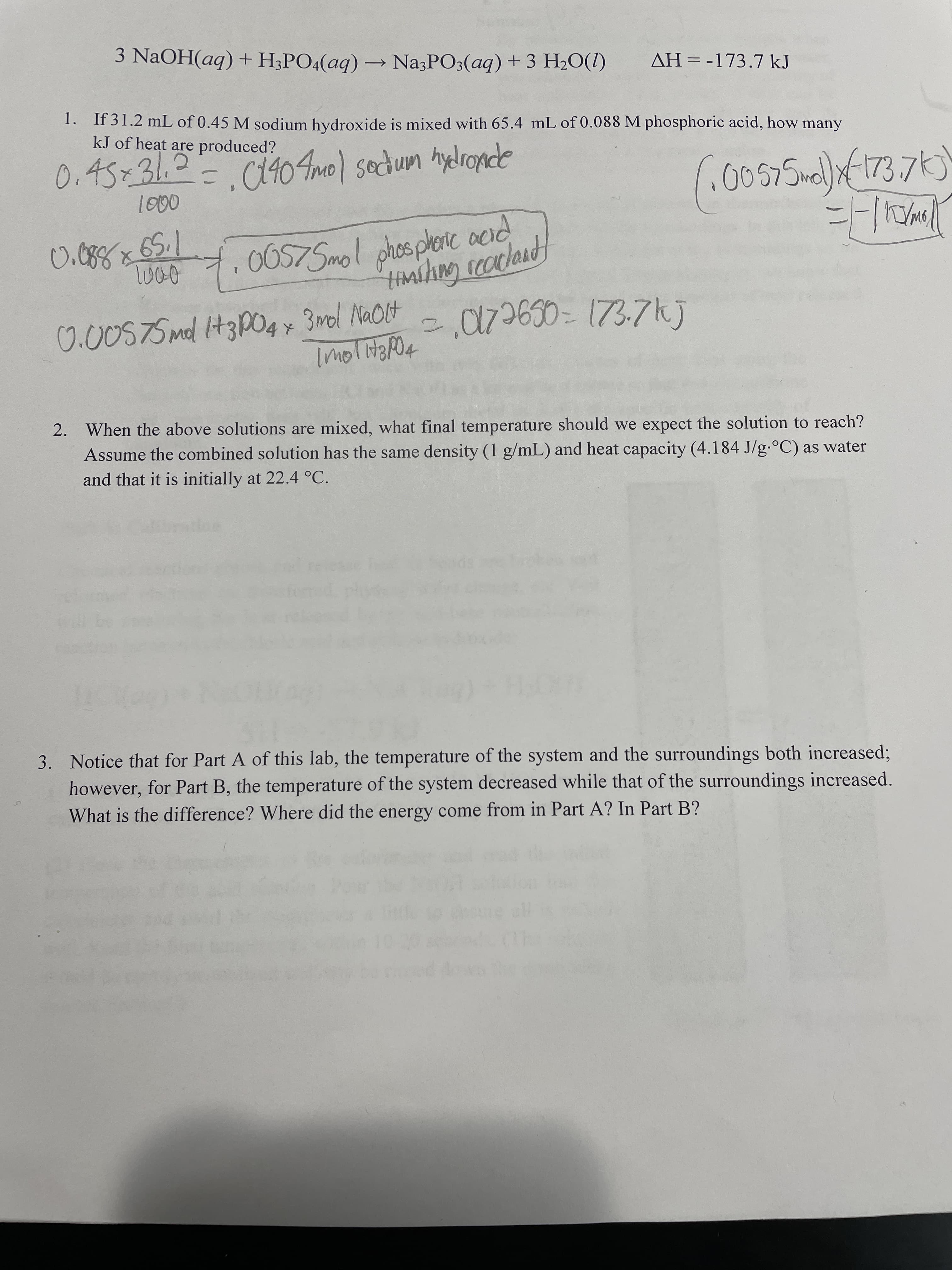3 NaOH(aq) + H;PO4(aq) → Na;PO3(aq) + 3 H2O(1) AH = -173.7 kJ 1. If 31.2 mL of 0.45 M sodium hydroxide is mixed with 65.4 mL of 0.088 M phosphoric acid, how many kJ of heat are produced? 0.45=31.2-140Amo) sedum hydrode Amo) sedun hydronde Himihingreacland 0.00575 ml IH3PO4x 3mol NaOlt 2. When the above solutions are mixed, what final temperature should we expect the solution to reach? Assume the combined solution has the same density (1 g/mL) and heat capacity (4.184 J/g.°C) as water and that it is initially at 22.4 °C. Notice that for Part A of this lab, the temperature of the system and the surroundings both increased; however, for Part B, the temperature of the system decreased while that of the surroundings increased. What is the difference? Where did the energy come from in Part A? In Part B?
3 NaOH(aq) + H;PO4(aq) → Na;PO3(aq) + 3 H2O(1) AH = -173.7 kJ 1. If 31.2 mL of 0.45 M sodium hydroxide is mixed with 65.4 mL of 0.088 M phosphoric acid, how many kJ of heat are produced? 0.45=31.2-140Amo) sedum hydrode Amo) sedun hydronde Himihingreacland 0.00575 ml IH3PO4x 3mol NaOlt 2. When the above solutions are mixed, what final temperature should we expect the solution to reach? Assume the combined solution has the same density (1 g/mL) and heat capacity (4.184 J/g.°C) as water and that it is initially at 22.4 °C. Notice that for Part A of this lab, the temperature of the system and the surroundings both increased; however, for Part B, the temperature of the system decreased while that of the surroundings increased. What is the difference? Where did the energy come from in Part A? In Part B?
Chemistry & Chemical Reactivity
10th Edition
ISBN:9781337399074
Author:John C. Kotz, Paul M. Treichel, John Townsend, David Treichel
Publisher:John C. Kotz, Paul M. Treichel, John Townsend, David Treichel
Chapter5: Principles Of Chemical Reactivity: Energy And Chemical Reactions
Section5.6: Calorimetry
Problem 5.7CYU: Assume 200. mL of 0.400 M HCl is mixed with 200. mL of 0.400 M NaOH in a coffee-cup calorimeter The...
Related questions
Question
I need help with 2 and 3

Transcribed Image Text:3 NaOH(aq) + H;PO4(aq) → Na;PO3(aq) + 3 H2O(1)
AH = -173.7 kJ
1. If 31.2 mL of 0.45 M sodium hydroxide is mixed with 65.4 mL of 0.088 M phosphoric acid, how many
kJ of heat are produced?
0.45=31.2-140Amo) sedum hydrode
Amo) sedun hydronde
Himihingreacland
0.00575 ml IH3PO4x 3mol NaOlt
2. When the above solutions are mixed, what final temperature should we expect the solution to reach?
Assume the combined solution has the same density (1 g/mL) and heat capacity (4.184 J/g.°C) as water
and that it is initially at 22.4 °C.
Notice that for Part A of this lab, the temperature of the system and the surroundings both increased;
however, for Part B, the temperature of the system decreased while that of the surroundings increased.
What is the difference? Where did the energy come from in Part A? In Part B?
Expert Solution
This question has been solved!
Explore an expertly crafted, step-by-step solution for a thorough understanding of key concepts.
This is a popular solution!
Trending now
This is a popular solution!
Step by step
Solved in 4 steps with 3 images

Recommended textbooks for you

Chemistry & Chemical Reactivity
Chemistry
ISBN:
9781337399074
Author:
John C. Kotz, Paul M. Treichel, John Townsend, David Treichel
Publisher:
Cengage Learning

General Chemistry - Standalone book (MindTap Cour…
Chemistry
ISBN:
9781305580343
Author:
Steven D. Gammon, Ebbing, Darrell Ebbing, Steven D., Darrell; Gammon, Darrell Ebbing; Steven D. Gammon, Darrell D.; Gammon, Ebbing; Steven D. Gammon; Darrell
Publisher:
Cengage Learning

Chemistry by OpenStax (2015-05-04)
Chemistry
ISBN:
9781938168390
Author:
Klaus Theopold, Richard H Langley, Paul Flowers, William R. Robinson, Mark Blaser
Publisher:
OpenStax

Chemistry & Chemical Reactivity
Chemistry
ISBN:
9781337399074
Author:
John C. Kotz, Paul M. Treichel, John Townsend, David Treichel
Publisher:
Cengage Learning

General Chemistry - Standalone book (MindTap Cour…
Chemistry
ISBN:
9781305580343
Author:
Steven D. Gammon, Ebbing, Darrell Ebbing, Steven D., Darrell; Gammon, Darrell Ebbing; Steven D. Gammon, Darrell D.; Gammon, Ebbing; Steven D. Gammon; Darrell
Publisher:
Cengage Learning

Chemistry by OpenStax (2015-05-04)
Chemistry
ISBN:
9781938168390
Author:
Klaus Theopold, Richard H Langley, Paul Flowers, William R. Robinson, Mark Blaser
Publisher:
OpenStax

Chemistry: Principles and Reactions
Chemistry
ISBN:
9781305079373
Author:
William L. Masterton, Cecile N. Hurley
Publisher:
Cengage Learning

Chemistry: Principles and Practice
Chemistry
ISBN:
9780534420123
Author:
Daniel L. Reger, Scott R. Goode, David W. Ball, Edward Mercer
Publisher:
Cengage Learning

EBK A SMALL SCALE APPROACH TO ORGANIC L
Chemistry
ISBN:
9781305446021
Author:
Lampman
Publisher:
CENGAGE LEARNING - CONSIGNMENT